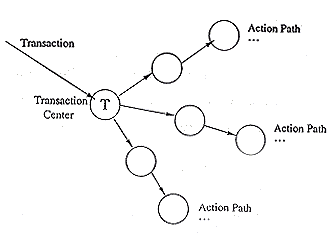| (a) | Software Engineering is often said to consist of three main components, namely methods, procedure and tools. Describe each of these three components. | [3] |
| Methods: these
are the how-to for building the software (or the actual techniques used in
software development). (1 mark)Tools: these are the automated or semi-automated support for
methods.(1 mark)
Procedures: Define the sequence (or correct procedure) in which methods are applied, and makes sure that the development of software is logical (i.e. flows in correct order) and is on time. Candidates indicating procedures as … glue that holds… are to be awarded zero marks. Correct alternative answers should also be given credit.
|
||
| (b) | One of the main problems faced in requirements analysis is the lack of understanding between the developer and the user of the software. Identify two communication techniques that have been proposed that can help to overcome this problem. | [2] |
| Facilitated
application specification technique.(1 mark) Preliminary meeting or interview (1 mark)
|
||
| (c) | The three components of the Information Domain are flow, content, and structure. Describe each of these terms. | [3] |
| Information
Flow: represents the manner in which the data and control changes as data and control
moves through a system. (1 mark) Answers which simply state "the way in
which data and control moves through a system" are to be given no marks. Information Content: represents the individual data and control items that make large items of information (1 mark). Information Structure: represents the internal organisation of various data and control items (1 mark). Correct alternative answers should also be given credit.
|
||
| (d) | One of the two types of data flows possible in a data flow diagram is transaction flow. With the aid of a diagram, describe what is meant by this term. | [5] |
| Information flow is
characterised by a single data item, called a transaction, that triggers other data flow
along one of many paths (1 mark). The transaction is evaluated and, based on its value,
flow along one of many action paths is initiated (1 mark). The hub of information flow
from which many action paths flow is called a transaction centre (1 mark).
2 marks for diagram. I mark for a generally correct structure of the diagram, 1 mark for correct identification and labelling of entities in the diagram. Correct alternative answers should also be given credit.
|
||
| (e) | There are a number of distinctive characteristics of the Jackson Structured Programming technique. Identify, and explain briefly any two of these characteristics. | [4] |
| Non-inspirational:
depends on little, or not at all, on invention or insight on the part of the engineer (1
mark).Rational:
design procedure is based on reasoned principles (1 mark).
Teachable: people can be taught to practice the method (1 mark). Practical: the method itself is simple, easy to understand and can be straightforwardly implemented (1 mark). Any two of the above, 1 mark for identification and 1 mark for a suitable explanation.
|
||
| (f) | With respect to Software Quality, MaCall proposes a categorisation which focuses on three important aspects of a software product. These three categories are Product Operations, Product Revision, and Product Transition. Describe each of these three categories briefly. | [3] |
| Product
Operations: software product’s operational characteristics (1 mark). Product Revision: ability to undergo change (1 mark). Product Transition: adaptability to new environments (1 mark). Other suitable explanations should also be given credit. |
